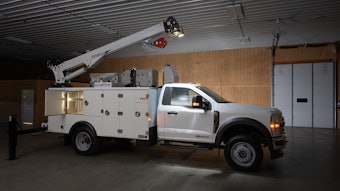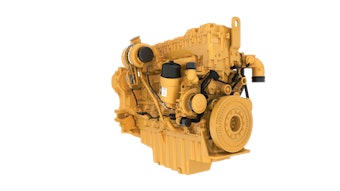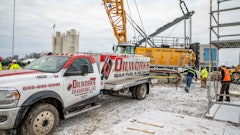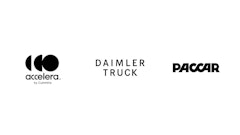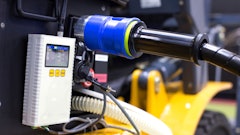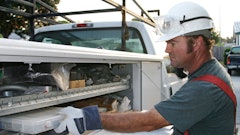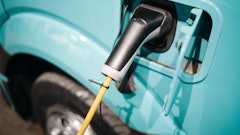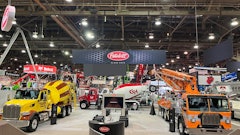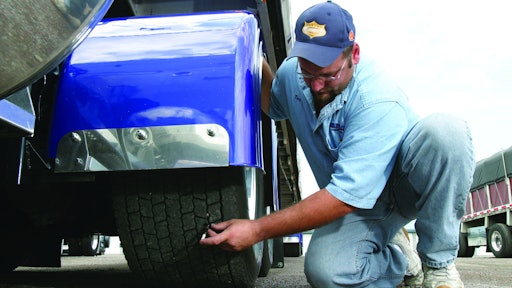
Choosing the right tires for your medium- and heavy-duty trucks directly impacts owning and operating costs. But there is no simple formula that gives you the best setup.
“It depends upon the environment in which the trucks operate,” says Gary Enterline, Michelin market segment manager. “The biggest mistake would be not understanding your complete tire working environment and not talking with your tire dealer to help select the right tire for your needs.”
A common mistake, which comes from not understanding the working environment, is overestimating the off-road traction needs for the rear axles on a dump truck. “If an aggressive tire is chosen for the rear axles when a less aggressive all-position tire would work fine, there is a good chance the customer’s expectations of tire performance and removal mileage will not be met,” Enterline states.
“The best tire for an application is determined by knowing more about the application of the tire and the conditions in which it will operate,” he continues. “Load, speed, surface conditions and type of driving are key. First, know the load limit of your vehicle setup. With this load, what are the speeds that you can operate? Are you going to do a lot of start/stop driving like in urban conditions or will there be a mix of urban and regional? Is there any off road, and what impact will a more aggressive tread have on load and speed?”
There is no universal solution. “Unfortunately, it is difficult to find a tire that covers everything 100%,” says Roger Stansbie, Continental Tire - the Americas. “There are some trade-offs. Really, it depends on you, as a skilled operator, to listen to the service engineers from the manufacturers or suppliers. They will give you the best compromise for the best residual application.”
Recommendations are based on your input. “Describe your fleet operation to the best of your ability and be honest,” says Stansbie. Don’t just say the tires are always inflated and you only go down a paved road. Tell the truth. That specialist has to make a value judgment based on your description.
Make the best compromise
“There are compromises to be made,” says Enterline. “A more aggressive off-road tire will most likely have a reduced maximum speed and the removal mileage will probably be less than a tire designed for on-road service. The durability or toughness of the tire is matched to the appropriate service condition in which it is intended to operate. The more aggressive off-road tire has a stronger sidewall than the on-road tire.”
Tires with a more aggressive tread pattern offer more void area in the tread, which improves off-road traction. “Tires with higher void ratios will typically have higher wear rates,” Enterline notes. “The tread depth on some aggressive tires is deeper to also help improve off-road traction. But the more aggressive treads will usually have lower removal mileages than a less aggressive tread.”
Wear rates for specific tires really depend on the application. “It is not necessarily the case that [your tire is] going to wear faster just because you have block patterns,” says Stansbie. The wear with block pattern tires will occur when running on paved surfaces. “That’s where you might end up with some wear problems.”
The tread compound plays a key part in this. If you frequently run off road, you will want a cut- and chip-resistant compound. However, these compounds can wear rapidly when used on road.
“Tread compounds are very important for all tires and have a significant impact on the overall performance,” says Enterline. “On-road/highway tires will be more oriented toward wear and efficiency, while the off-road tire may need a compound to resist chipping and tearing of the tread block.”
Match tires on axles
While it may be ideal to have matching tires all the way around, it is not necessary. “It’s not uncommon at all to have different brands of tires on the steer and drive axles, but it’s best to use the same brand of tire and tire type on the same axle,” Enterline advises.
Stansbie adds, “Most manufacturers suggest you use like tires matched by type, etc. But it depends on your situation.” You may need to replace a damaged tire with another make or model to keep running. “It is not necessarily a safety situation by mixing tires, as long as they are reputable tires and they are in good condition, and you spec the same size and type of tire.”
When a tire does become damaged and needs to be replaced, try to find another tire with similar wear. For example, if a tire is 50% worn, try to find another tire that is also 50% worn.
“But if you do replace it with a new tire, there are benefits to change it out as soon as possible to match the overall tread depths from tire to tire,” Stansbie indicates. If you don’t, the wear rate of the new tire will dramatically increase due to the difference in diameter.
“It’s possible to mix brands on an axle (not preferred), but tires mounted as a dual set must be within 1/4 in. diameter of each other,” says Enterline. “And if there is a 6x4 configuration, all tires on each rear axle must be within 1/4 in. of each other, and the average tire diameter of the tires on the front axle must be within 1/4 in. of the average tire diameter on the rear axle.”
If tires are not matched properly by diameter, the larger diameter tire will carry a disproportionate share of the load, which can lead to rapid or uneven wear, excessive fatigue and premature tire failure. “A replacement tire mounted in a dual position with the same brand and tire type must have tread depths within 4/32 in. of each other,” says Enterline.
“Within 4/32 in., you can run tires side by side,” adds Stansbie. “Anymore than that and you run the risk of having one tire wear faster than the other.”
Different types of tires can have slightly different diameters for a given size. “There can be slight variations between tire types from the same brand and from different brands,” says Enterline. “Check the manufacturer’s specifications for details. There could be enough difference between tire types and brands that they should not be mounted together in a dual application.”
“The ideal situation is you match the tires, because each tire from each manufacturer has its own characteristics regarding tire dynamics,” says Stansbie. Take steer tires, for example. “From manufacturer to manufacturer, you may end up having one tire fighting the other. At best, it could be just an irregular wear situation where you find that one tire is wearing faster than the other because the conditions would favor the best tire. At worst, it would be a handling problem, which would be steer and understeer coming from those tires.”
Not all are created equal
You can’t visually tell if a tire is appropriate for your application. “There can be significant differences between different brands of on/off-road vocational tires — both construction of the tires and their performance,” says Enterline. “Tires designed for more severe off-road service may have a reinforced casing and this will vary by manufacturer.”
Don’t buy the cheapest tire with the expectation that it will lower your costs. “You want to save money, I know that,” says Stansbie. “Most manufacturers’ whose tires cost a little bit more than normal are that way because of a good reason. For vocational applications, retreading is probably going to be a key factor in their usage. Getting a reputable tire that gives you two or three retreads is going to drastically reduce your running costs.”
Some cheaper brands cut corners. “Of course, you could put a less robust cord or reinforcement... into what looks like a true off-road tire. Some manufacturers do that to keep their costs down. From a manufacturers’ point of view, you should go with the best tire that you can afford because it is more in line with professional applications,” says Stansbie.




